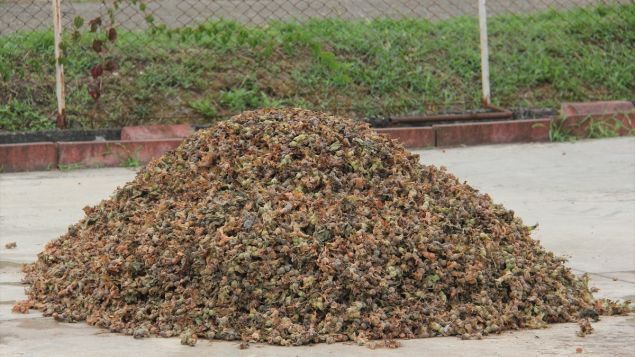

I would like to give you some information about the aflatoxine amounts in nutrients which are recently important to be considered.
“ The maximum Aflatoxine M1 limit is indicated as 0,050 µg/kg for the using milk in the production of raw milk, heat- treated milk and milk- based products within the Contaminant Regulation on Turkish Food Codex which is published in the official journal at the date of 29.12.2011. “
Aflatoxine is one of the toxic substances which moulds cause. The toxic substances which cause from moulds and mushrooms are generally called mycotoxin.
Aflatoxine M1 is a toxin which occurs as a result of abnormal mould growth of the feed or raw material of feed and contaminates to milk of the animals which consumes the feeds that involve Aflatoxine B1 toxin.
Some of Aflatoxine B1 return to Aflatoxine M1 in livers of the cows, they are excreted to milk with the milk glands and as a result of this circumstance; other milk products can be contaminated with Aflatoxine M1. The negative effects of toxins on human health are the most important reasons for its’ existence in milk and milk products.
Aflatoxines cause carcinogenic and mutogenic problems and developmental disorders. Besides; they are important for being resistant against the heat applications and posing danger for the people and animals.
Aflatoxines can cause acute and cronical poisonings for people and animals depending upon the intake amount and process. Chlorosis, anorexia, hemolytic anemia, diarrhea and such diseases are generally seen in acute poisoning. As a result of the long- term intake of aflotoxine in low levels; liver cancer, cronical chlorosis and cirhosis risks are increased.
The types of milk should importantly be considered in order to avoid the risks which may occur. Some of these types are not controlled in terms of food security, cold chain and chemical contaminations.
Aflatoxines may occur in corn, barley, oat, wheat and such raw materials. They have substantial damages on animals arising from moulds and mushrooms and are contaminated by feeds for the cows.
Mould growth in feeds, causes problems for the livestock. Currently, I would like to mention you about these which are seen in ruminants.
Inappetency, decrease in milk amount, growth deficiency, decrease in feed conversion, loss of weight, diarrhea, bloody diarrhea, fertility difficulties, abnormal rutting loops, coarsening in feathers, flushing and degredation, depression, rectum prolapsus, anger, immune system irregularities and such diseases can be faced with as being the results of mitatoxines.
The deficiencies which are especially seen in the immune system, cause many other problems.
Mycotoxins should also be considered as the factors which cause pramature embryonic death, rutting indications of the pregnant cows, ketosis, replacement of omasum, metritis, mastitis, fatty liver syndrome, etc.
They distrupt nutrient absorption. The blood Vitamin A level decreases for the animals which are fed with diuturnal mouldy feed and the possibility for dead birth can be mentioned about. As a result of the rapid growth of moulds and mushrooms in feed; decreases in the energy level and vitamins A, D, E, K are going to be observed.
Mycotoxins like hot and humid environments. They damage the beneficial and digestive microorganisms in rumen. The pregnant animals are affected from this circumstance more than the young and growing adult ones. Livers are the limbs in which the most serious and underlying problems occur. The purification, immunity and hormonal mechanisms of the body, lose their functions with liver deterioration.
If the bloodstream about 600 lt is required to be provided for 1LT milk synthesis, then carrying aflatoxines to udders will be inevitable.
In order to avoid aflatoxines; the silage craters should be filled rapidly, closed suitably and an anaerobic environment should be provided as soon as possible.
The usage of silage is also very important. It should be upright, cut straightly and covered up once again.
The stock and storage conditions of roughage in businesses, can provide suitable conditions for aflatoxine. We should pile up our bales carefully, dessicate and store our feeds in the cool and dry places.
If aflatoxine exists in the bodies of our animals, we should feed them carefully and take care of them by using toxine connectors.
Personally, I am suggesting all of our producers to be careful about stocking and preserving feed materials and make required controls and intervention before feeding in order to avoid aflatoxine.
I wish an abundant and a profitable new year for our producers...
Register to our newsletter in order to be aware of our announcements and news.
